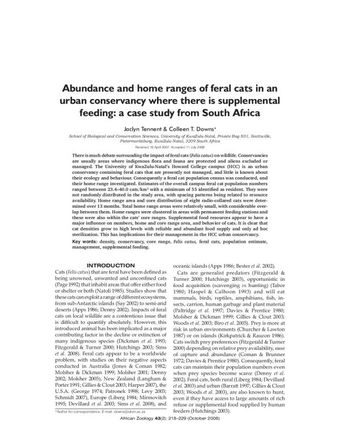Priority Forests for Conservation in Fiji: landscapes, hotspots and ecological processes
- Description:
- Fijis National Biodiversity Strategy and Action Planencourages re nementstoconservation priorities based on analyses of new information. Here we propose a network of Priority Forests for Conservation based on a synthesis of new studies and data that have become available since legislation of the Action Plan in 2001. For selection of Priority Forests we considered minimum-area requirements for some native species, representation goals for Fijis habitats and species assemblages, key ecological processes and the practical realities of conservation areas in Fiji. Forty Priority Forests that cover 23% of Fijis total land area and 58% of Fijis remaining native forest were identi ed. The analysis con rms the majority of conservation priority areas previously identi ed, recommends several new areas, and supports the Government of Fijis policy goal of protecting 40% of remaining natural forests to achieve the goals of the National Biodiversity Strategy and Action Plan and sustain ecosystem services for Fijian communities and economies.
- Collections:
- Secretariat of the Pacific Regional Environment Programme (SPREP)
- Publisher:
- 2009
- Content partner:
- Secretariat of the Pacific Regional Environment Programme (SPREP)
- Availability:
- Not specified
-
Copyright status: All rights reservedFind out more about what you are able to do with this itemThis item is all rights reserved, with means you'll have to get permission from Secretariat of the Pacific Regional Environment Programme (SPREP) before using it. For more information, please see our use and reuse page.What can I do with this item?Non-infringing useNZ copyright law does not prevent every use of a copyright work, and this item may be hosted by an international institute or organisation. You should consider what you can and cannot do with a copyright work.No sharingYou may not copy and/or share this item with others without further permission. This includes posting it on your blog, using it in a presentation, or any other public use.No modifyingYou are not allowed to adapt or remix this item into any other works.No commercial useYou may not use this item commercially.
Related items
Welcome and warm Pasifik greetings
The information on this site has been gathered from our content partners.
The names, terms, and labels that we present on the site may contain images or voices of deceased persons and may also reflect the bias, norms, and perspective of the period of time in which they were created. We accept that these may not be appropriate today.
If you have any concerns or questions about an item, please contact us.
